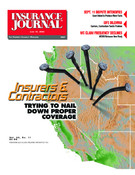Like most insurance companies, the soft market took its toll on Safeco.
While the property and casualty side of the business continued to suffer losses that resembled the gross national product of some Latin American countries, the board of directors at the Seattle-based insurance conglomerate relied heavily on the Life and Investment side of the business to keep the ledgers balanced. The millions of dollars in losses from property and casualty reduced dividends to shareholders and cost two CEOs their corner office.
In the first quarter of this year, new CEO Mike McGavick told his stockholders that the company netted pre-tax income of $59.1 million from the Life and Investment to offset the losses from the other side of the business. But, he promised, a hardening market and a variety of new products will bring an end to the red ink generated by P&C.
“We’re rolling out new products,” McGavick said. “We’re focusing on profitable sales.”
Part of the revised earning projections may come from the company’s investment into an untapped potential market: Terrorism insurance at low risk locations.
In April, Safeco dedicated an electronic scoreboard at a youth baseball facility at Mel Olson Stadium in the White Center community south of Seattle. The company plans to install 62 scoreboards across the country over the next two years as part of a $1 million investment into Insurance Pro’s “Play Ball” program.
“Play Ball is a great way to honor our agents and the neighbors they care about,” McGavick said.
Are the directors at Safeco just fans of America’s pastime, or is there a more profitable message in the investment?
While the company is not in a position to underwrite terrorism insurance for large, public facilities; it might be positioning itself to cover many of the smaller targets away from major urban centers.
Peggy Kreger, Safeco’s assistant vice president for business underwriting, pointed out that many of the company’s clients are located away from metropolitan areas, making them less likely targets for terrorists. That list includes a high concentration of customers in cities like Missoula, Montana and Ardmore, Oklahoma where—coincidently—Safeco will be putting its corporate logo on billboards at local ball fields.
Can 17,000 independent Safeco agents across the country parlay an electronic scoreboard into the sale of high profit, lower risk terrorism insurance? Certainly the folks in Scott City, Missouri and Kingston, Tennessee need insurance to cover the possibility that a suicide bomber will drive his old Ford pick up truck into the concession stand at the local Little League field.
Surely parents in Fort Smith, Arkansas and Seaside, Oregon need protection against the possibility that terrorists might use Anthrax in place of chalk to mark the first and third base lines.
Four years ago the financial world snickered when Safeco paid $40 million for a 20-year agreement to become the corporate sponsor of the new retractable-roof baseball stadium in Seattle. But the skyrocketing popularity of the Seattle Mariners has made that investment look like a bargain.
These days the name Safeco appears more often on ESPN than the insurance company is mentioned on the Bloomberg Report. Last season, when the Seattle Mariners won major-league record 116 games, the stadium was on the nightly news more often than Dick Cheney.
Ironically, Safeco is not in a position to write insurance for its own namesake. Company spokesman Paul Hollie said the company limits itself to small and medium sized business risks and would not even consider potential targets like Seattle’s 46,000-seat stadium or the Space Needle.
“We’d probably only write a coffee shop near the Space Needle with the proper exclusions,” Hollie said. In states that allow them, Safeco has added terrorism exclusions to all new business policies and renewals.
When the Mariners looked into coverage of their own on the $517 million stadium last October, the only terrorism insurance available was capped at $1 million per incident.
In Milwaukee, the cost of insurance at two year-old Miller Field jumped exponentially this year, from $225,000 to more than $2.25 million. Premiums at the Metrodome in Minneapolis almost doubled from last year’s rate of $283,000 to $500,000.
So, a million bucks for 32 scoreboards this year and 30 more in 2003 may be a great use of the marketing budget at Safeco. And it may just give the company the high-profit low-risk type of business other providers may have overlooked.
Dan Aznoff is the former editor of Insurance West. He now covers the Seattle Mariners and baseball in the Pacific Northwest for The Baseball Journal. Aznoff is a freelance writer who makes his home in Bellevue, Wash. He can be reached at DAjurnalist@msn.com.
Topics Catastrophe Property Casualty
Was this article valuable?
Here are more articles you may enjoy.


 German Insurtech Wefox to Replace CEO After Board Rejects Mubadala Sales Plan
German Insurtech Wefox to Replace CEO After Board Rejects Mubadala Sales Plan  Zurich to Buy AIG’s Travel Insurance Business for $600 Million
Zurich to Buy AIG’s Travel Insurance Business for $600 Million  US Home Insurance Still Priced Too Low for Climate Risk, Says Swiss Re Chair
US Home Insurance Still Priced Too Low for Climate Risk, Says Swiss Re Chair  Allstate, Nationwide Post Dramatic Q12024 Homeowners Loss Ratio Drops: S&P
Allstate, Nationwide Post Dramatic Q12024 Homeowners Loss Ratio Drops: S&P 


